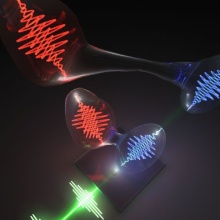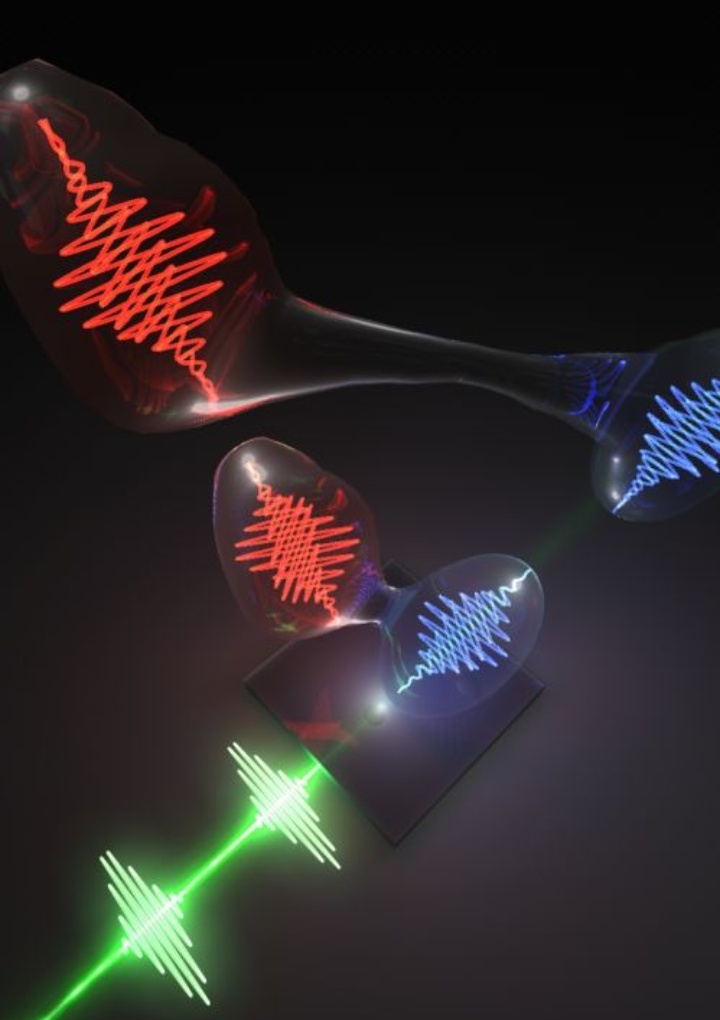Encryption technologies with the help of quanta (quantum cryptography) or optical quantum computing require special light conditions, so-called indistinguishable and interlocked photon pairs, in well-defined temporal pulses. Existing procedures to generate these, however, lead to results occurring more by chance in view of the number of photon pairs in one pulse. The consequences are errors in the quantum algorithms that greatly restrict their usefulness for deterministic quantum technologies that depend on the predictive accuracy. In an experiment based on a semi-conductor quantum point, physicists from the University of Stuttgart have now shown how it is possible to generate single indistinguishable photon pairs based on parametric down conversion at the push of a button, so to speak. The work was published in the renowned specialist journal Nature Photonics*.
Semi-conductor quantum points are ideally suited to generate interlocked photon pairs due to their properties. In this way the quantum point can be stimulated through a short optical or electrical pulse, and subsequently a so-called photon pair based on parametric down conversion can be released if the conditions are suitable and be used for applications. In the case of such photon pairs, the polarisation of each single photon is initially completely undefined. Only the targeted measurement on one of the two photons also enables a direct statement on the polarisation of the second photon, but this occurs immediately. In so doing it is irrelevant to what extent the single photons are separated from each other spatially. This property is exploited in a targeted way in the quantum technologies, for example for bug-proof communication.
In work up to now to generate interlocked photon pairs, the quantum points were optically stimulated electrically or in a non-resonant way. This method of stimulating, however, entails some disadvantages. In this respect, exactly two electron pair of holes are not stimulated for each stimulation pulse and subsequently two photons (an interlocked photon pair) emitted. It is rather the case that only one single proton or more than two photons are released. The fact that these stimulation conditions also generate many charge carriers in the environment of the quantum point is even more problematic. The interaction between these charge carriers and the charge carriers in the quantum point leads to so-called decoherence processes, that ultimately limit the indistinguishability of the photons.
Physicists at the Institute of Semiconductor Optics and Functional Interfaces under the management of Prof. Dr. Peter Michler have now succeeded of stimulating the quantum point with exactly two electron pair of holes with a so-called resonant two-photon stimulation process. Consequently, only one interlocked photon pair is emitted through this. Moreover, it was able to be shown that the photons generated in this resonant way are undistinguishable to a great extent, making them well suited for the aforementioned applications.
The more exact photon pair generation rate of 86 percent achieved in this way was able to be determined in cooperation with the theoretic physicist Dr. Martin Glässl from the University of Bayreuth. This joint work is now the starting point for a range of further experiments in which the photon source is to be used for experiments on the quantum teleportation of photons, for example.
* Original publication: M. Müller, S. Bounouar, K. D. Jöns, M. Glässl, and P. Michler, Nature
Photonics, DOI 10.1038/nphoton.2013.377
Further information:
Prof. Dr. Peter Michler, Institute of Semi Semiconductor Optics and Functional Interfaces,
Tel. 0711/685-64660,
Email: p.michler (at) ihfg.uni-stuttgart.de,
www.ihfg.uni-stuttgart.de/.



